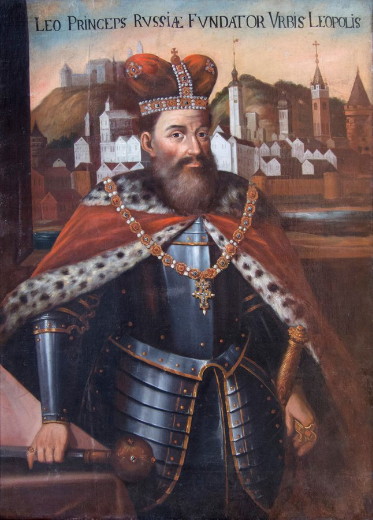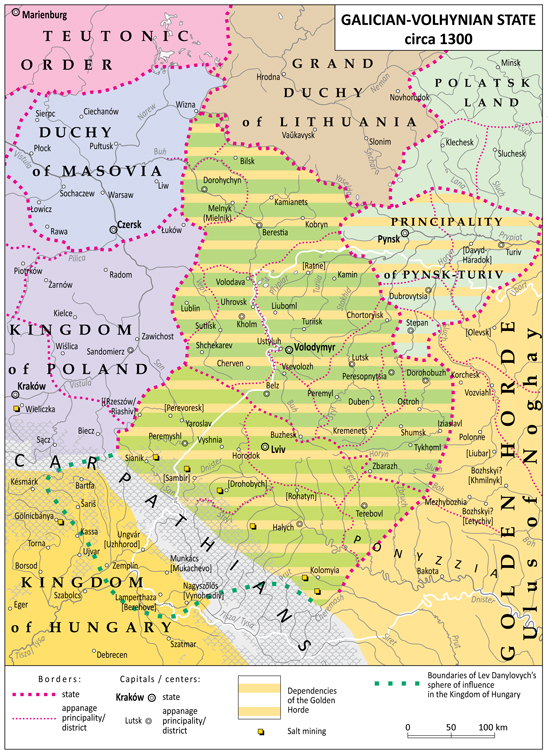Galicia-Volhynia, Principality of
Galicia-Volhynia, Principality of. A state founded in 1199 by Roman Mstyslavych, the prince of Volhynia from 1170, who united Galicia and Volhynia under his rule. The Romanovych dynasty ruled the state until its demise in 1340.
After the death of Grand Prince Yaroslav the Wise of Kyiv in 1054, Kyivan Rus’ had disintegrated into 5 and then 13 separate principalities, including Halych principality (Galicia) and Volodymyr principality (Volhynia). Roman Mstyslavych took the princely Halych after the death of Volodymyr Yaroslavych and in 1202 occupied Kyiv with its domains as far east as the Dnipro River, thereby creating a powerful state in western Rus’. Like other princes before and after him, he had to contend with a rebellious Galician boyar oligarchy throughout his reign. He died in battle at Zawichost against Prince Leszek of Cracow. Interminable boyar rebellions arose, which Leszek and Andrew II of Hungary exploited, and in 1214 they occupied Peremyshl and Halych. In 1221 Prince Mstyslav Mstyslavych of Novgorod the Great drove the Hungarians from Halych, where he ruled with difficulty until 1228.
The rebellions and wars lasted until 1238, when Roman Mstyslavych's son, Danylo Romanovych, having consolidated his rule in Volhynia, finally seized Galicia. After subduing the boyars in 1241–2 and defeating the Chernihiv princes and their Polish and Hungarian allies at Yaroslav (see Battle of Yaroslav) in 1245, Danylo Romanovych consolidated his control of Galicia. He took Hrodna, Slonim, and other Chorna Rus’ towns from Lithuania in the north in 1250–2 and extended his rule beyond Kyiv in the east. Because of Danylo Romanovych's close alliance with his brother Vasylko Romanovych, who ruled Volodymyr (in Volhynia) from 1241 to 1269, the Galician-Volhynian state attained the apex of its power during his reign. After the enormous destruction wreaked by the Mongol invasion of Rus’ in 1239–41, Danylo Romanovych was forced to pledge allegiance to Batu Khan of the Golden Horde in 1246. He strove, however, to rid his realm of the Mongol yoke by attempting, unsuccessfully, to establish military alliances with other European rulers. In internal affairs, Danylo depended on the support of the burghers. During his reign the cities of Lviv and Kholm were founded. After the Mongols razed Halych in 1241, Kholm became the new capital.
Danylo died in 1264. His son and successor, Lev Danylovych (1264–1301), accepted Mongol suzerainty. Lev made Lviv the new capital in 1272 and took part of Transcarpathia, including Mukachevo, from the Hungarians in 1280 and the Lublin land from the Poles ca 1292. His son and successor, Yurii Lvovych (1301–15), formally reunited Galicia and Volhynia and succeeded in getting Halych metropoly established, but lost Transcarpathia and the Lublin land. His sons, Lev Yuriiovych and Andrii Yuriiovych, ruled together from 1315 to 1323. They encouraged commerce and colonization by foreign merchants, mainly Germans. The brothers joined forces with Polish princes to fight the Mongols and possibly perished in battle. The last prince, Yurii II Boleslav (1323–40), the nephew of Yurii Lvovych, also encouraged foreign colonization, which led to conflicts with the boyars, who poisoned him and offered the throne to the Lithuanian prince Liubartas. That same year Casimir III the Great of Poland attacked Lviv, and the period of Lithuanian-Polish rivalry over Galicia-Volhynia began (see Lithuanian-Ruthenian state).
Because the powerful and influential boyars constantly competed for power with the princes, certain tendencies toward feudalism existed in the principality, unlike in other parts of Ukraine. trade with other Rus’ principalities, Hungary, Poland, Bohemia, the Holy Roman Empire, Lithuania, Bulgaria, and the Byzantine Empire was developed, and the principality prospered. It also flourished culturally, as evidenced by architectural remains and various chronicles, especially the Galician-Volhynian Chronicle. With the death of Yurii II Boleslav, it ceased existing as a separate state, and with it the Princely era in Ukraine came to an end. Over 80 towns and cities were located in the principality.
BIBLIOGRAPHY
Zubritskii, D. Istoriia drevniago Galitsko-russkago kniazhestva, 3 vols (Lviv 1852–5)
Sharanevych, I. Istoriia Halytsko-Volodymyrskoi Rusy ot naidavniishykh vremen do roku 1453 (Lviv 1863)
Linnichenko, I. Cherty iz istorii soslovii Iugo-Zapadnoi (Galitskoi) Rusi XIV–XV st. (Moscow 1894)
Pashuto, V. Ocherki po istorii Galitsko-Volynskoi Rusi (Moscow 1950)
Hrytsak, P. Halyts’ko-Volyns’ka derzhava (New York 1958)
The Galician-Volhynian Chronicle: An Annotated Translation by George A. Perfecky. The Hypatian Codex, part 2 (Munich 1973)
Kryp'iakevych, I. Halyts’ko-Volyns’ke kniazivstvo (Kyiv 1984)
Kotliar, N. Formirovanie territorii i vozniknovenie gorodov Galitsko-Volynskoi Rusi IX–XIII vv. (Kyiv 1985)
Kotliar, M. Halyts’ko-Volyns’ka Rus’ (Kyiv 1998)
Hrushevsky, M. History of Ukraine-Rus', vol 3, To the Year 1340 (Edmonton and Toronto 2016)
Arkadii Zhukovsky
[This article originally appeared in the Encyclopedia of Ukraine, vol. 2 (1989).]

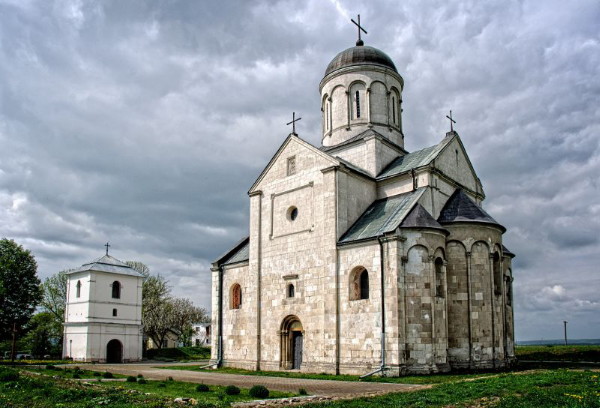
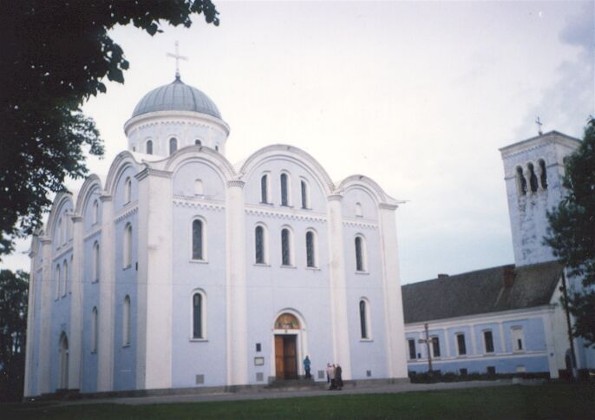
![N. Nevrev: Roman [Mstyslavych] of Halych Receives Envoys from Pope Innocent III (1875, The National Art Museum of the Republic of Belarus). Image - N. Nevrev: Roman [Mstyslavych] of Halych Receives Envoys from Pope Innocent III (1875, The National Art Museum of the Republic of Belarus).](https://www.encyclopediaofukraine.com/pic%5CR%5CO%5CRoman%20Mstyslavych%20Receives%20Envoys%20from%20Pope%20Innocent%20III%20(painting%20by%20M%20Nerovlev).jpg)
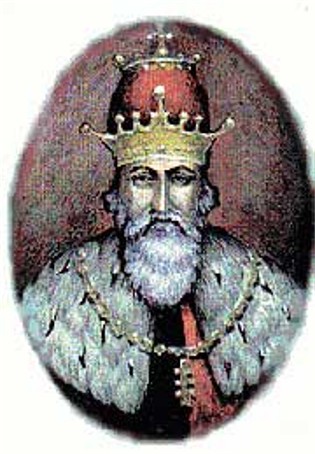
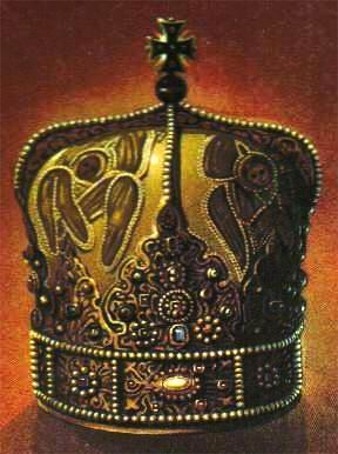
%20Luke.jpg)
